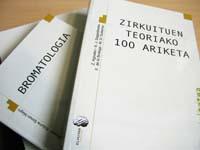Books in Basque at the university

At present, the Elhuyar Foundation has 23 book titles for the university in its catalogue, and soon will include the other five titles we now present. As for the subject, these five books can be divided into two independent groups each other.
Engineering and Engineering
In this group are the books Statistics, 100 exercises of Theory of circuits and Foundations of digital control. The three have been formed by engineers and university professors.
Statistics is a work produced by Itziar Gurrutxaga, Jon Iradi, Ibon Zamanillo and Ernesto Cilleruelo. Among other issues, the axiomatic and the calculation of probability, the one-dimensional and two-dimensional variables, the functions, the discrete and continuous distributions, the limit theorems, the theory of the valuation, the confidence interval and the distribution hypotheses, are worked in order to establish shared basic concepts of the industrial application statistics.
Zaloa Aginako, Koldobika Joseba Sagastabeitia, Faustino de la Bodega and M. For his part, Dolores Gutierrez has prepared the book of 100 exercises of Theory of Circuits. They complete a collection of 100 solved and commented exercises of electrical circuits for the use of university students of medium or higher grade. The topics covered are: waveforms, continuous current circuits and monophysical alternating current in permanent state, magnetic link circuits, etc.
Gerardo Tapia, Arantza Tapia and Julián Florez have produced the book “Fundamentals of digital control”. The topics covered were the mathematical treatment of sampling systems, the digital control systems, the analysis of discrete systems, the analysis of digital control systems and the components of the control loop, all complemented by the study of practical cases.
Food and nutrition
The books of Bromatology and Human Nutrition and Dietetics are the result of the work done by professors Edurne Simon and Bittor Rodriguez of the Faculty of Pharmacy of Vitoria-Gasteiz. Both can be useful, not only for teachers and university students, but also for nutritionists and dieticians.
In Bromatology we refer to definitions, classifications, deterioration and conservation of food and the main ingredients. Food groups also appear.
The book of human and dietary nutrition also analyzes the characteristics of nutrients. It provides information on the classification of nutrients, their nutritional use (ie their absorption, transport, metabolism and excretion), dietary sources and diseases related to this nutrient. In addition, other compounds present in foods such as dietary fiber and alcohol have been worked. To finish, the authors show the nutrition and dietetics adapted to each stage of life.





